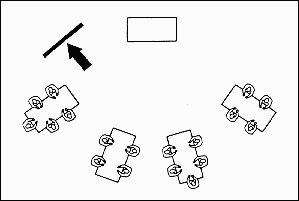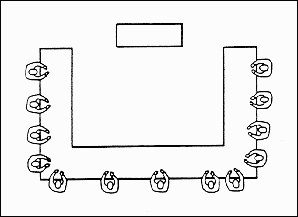Room/Layout
The site should have the following characteristics:
- Be available for a five-hour period plus time ahead to set up and time after to clean up
- Be easily accessible (parking near by, ramps)
- Be centrally located.
The room itself should have the following characteristics:
- Have restrooms and telephones close at hand
- Be comfortable for 25-30 people seated at small tables, allowing room for the presenter's table, equipment, and a screen.

If this arrangement is not possible, the room can be arranged in a horseshoe but this arrangement is awkward for small group discussions.

The Instructor will be responsible for arranging the equipment and presentation materials.
Equipment
You will need to arrange for the following:
- 35 mm slide projector (check with the facilitator they may need 2 projectors) and empty slide carousel
- Overhead projector
- Screen (2?)
- Flip chart, easel, and markers
- Spare bulbs for each projector.
A table and chair should be placed in the front of the room for the presenter.
Schedule and Agenda
You will be responsible for setting the date and establishing the Agenda for the Road Show, in coordination with the Instructor. When setting the date, allow enough time to send out invitations and gather the needed local information. A minimum of four weeks lead time is recommended.
Once the date has been confirmed, you need to set the best time for the Road Show. There is approximately four hours of content in the Road Show. To this you need to add two ten-minute breaks. Therefore, you should plan on a 4 ½ hour block of time.
Although the Road Show could be offered at various times during a day, the following options are the preferred scheduling approaches.
| Recommended: | 8:00 AM to 12:30 PM | This approach allows for two breaks and finishing in time for lunch. Citizen participants do not have to take too much time off of work. |
| Workable: | 1:00 PM to 4:30 PM | It is harder to generate enthusiasm after lunch but this schedule still keeps the group together. |
| Workable: | 10:00 AM to 4:30 PM | Spanning lunch allows the opportunity for a walking tour, but ties up too much of the day for many participants. Some participants will not return after lunch. |
|
Not Recommended: |
5:30 PM to 10:00 PM | This schedule seems to be least workable. Although private citizens may be more able to attend theoretically, very few people are eager to give up their evenings. The quality of discussion will deteriorate significantly the later the session runs. |
Refreshments
Depending on the final schedule you choose, you will need to arrange for some refreshments for the breaks. You should plan on having coffee and tea, at a minimum. Sodas and juice are recommended. If your session will be starting early in the morning, you might want to provide pastries. You should then inform the participants that a continental breakfast will be provided; this might increase your attendance.